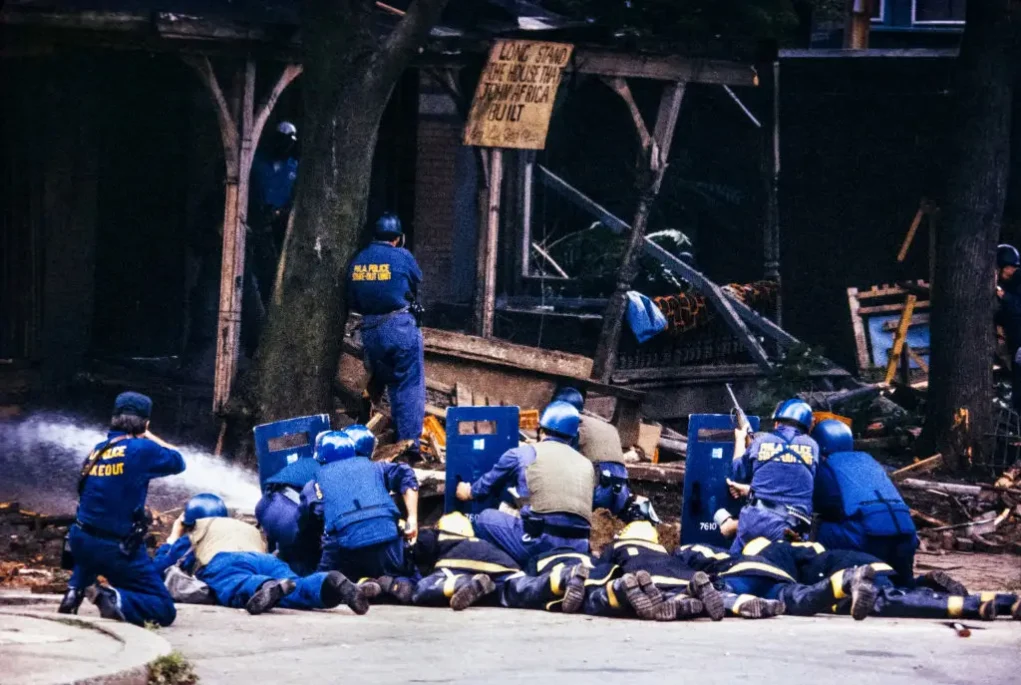Human remains of a 12-year-old girl who was killed in a police bombing in Philadelphia nearly 40 years ago were discovered last week at the Penn Museum, where they were stored among thousands of artifacts being relocated to an upgraded storage facility at the University of Pennsylvania.
Museum officials announced Nov. 13 that they discovered the remains, stating that they promptly informed the child’s family as soon as they were found. However, it was not clear whether the remains had been handed over yet to the surviving relative.
Researchers identified the remains as those of 12-year-old Delisha Africa, who was among those killed in the Osage Avenue police bombing in 1985, an event widely condemned as one of the most extreme acts of government violence in Philadelphia’s history, which remains a source of pain and anger for survivors and their families.

Last week’s shocking discovery of Africa’s remains follows a 2021 announcement by city officials, revealing that the remains of another bombing victim, 14-year-old Katricia Dotson, had been uncovered at the museum.
Both sets of remains stemmed from the infamous siege where police dropped an aerial explosive on the headquarters of a Black radical group known as MOVE — killing 11 people, including six children, and devastating a largely Black neighborhood in West Philadelphia.
MOVE’s charismatic leader, John Africa, was among the dead.
The remains of those killed in the bombing were initially believed to have been cremated and discarded or otherwise returned to family members years ago. However, the discovery of Dotson’s remains in 2021 revealed that some remains had been retained for forensic purposes, leaving the families of survivors stunned. Now, three years later, Africa’s remains turned up in the same collection of artifacts.
Penn said it had informed the Africa family of the findings but did not provide details.
The remains from the 1985 bombing were delivered to the University of Pennsylvania so that forensic researchers could help identify victims whose remains were in dispute. From there, the remains were placed under lock and key at the museum, a secret that was finally brought to light by The Philadelphia Inquirer in 2021.
In 2022, an independent investigation revealed that the institution only held the remains of a single individual whose identity could not be definitively established. These investigators also stated that there was no reliable scientific or factual evidence to support the claim that the museum was holding the remains of Delisha Africa.
Now, after two years, the Penn Museum purportedly came upon Africa’s remains last week during a careful inventory of cataloged artifacts. The girl’s remains were situated alongside historic items dating back more than a century, including thousands of human remains from ongoing archaeological excavations.
During the announcement, the museum did not explain exactly when the remains were discovered or how they had been overlooked for decades despite the facility’s expertise in archaeology and anthropology.
Additionally, the museum has not said how the remains came to be in its possession nor which staff members were responsible for acquiring them. No details were provided on the condition of the remains or how they were confirmed to be consistent with the identity of Delisha Africa.
Attorneys representing Lionel Dotson, Katricia’s surviving brother, who is suing the city over the mishandling of the remains, released a statement saying Delisha Africa’s remains were found despite “repeated assurances” from the city that the remains of all bombing victims had been returned to their families.
“For nearly 40 years, the City of Philadelphia, the University of Pennsylvania and the Penn Museum have refused to treat the MOVE Bombing victims or their families with the even most basic level of respect and decency and this latest revelation is just the most recent in a long line of atrocities Black folks in America have had to live with,” said Strom law firm attorneys Bakari Sellers and Daniel Hartstein. “We are disgusted and disappointed but, unfortunately, we are not surprised.”
A museum spokesperson stated that the institution has reevaluated its handling of human remains and is in the process of relocating items from its Biological Anthropology Section to newly upgraded, secure storage spaces, according to the Inquirer. The move is part of a broader reassessment of its practices surrounding the acquisition and management of sensitive materials like human remains.
Katricia Dotson’s remains were held by the Penn Museum for more than 35 years until April 2021, when the facility was exposed for having them in storage, the Strom law firm stated.
Mike Africa Jr., a member of MOVE and advocate who was 6 at the time of the bombing, reserved comment on the discovery of the remains, according to The New York Times. He announced plans to hold a news conference later this month featuring current and former officials, including W. Wilson Goode, the Philadelphia mayor in 1985 when the bombing occurred.
Previously, when the remains of Katricia Dotson were given back to the Africa family in 2021, Africa Jr. said he and other former MOVE members were unaware that her remains, including parts of a burned femur and pelvis, had been stored for decades.
MOVE, founded in Philadelphia by John Africa in 1972, was a radical Black separatist group steeped in unconventional beliefs and practices, whose members promoted a complete rejection of modern society while advocating anti-government ideology. The movement emphasized a return to nature and environmentalism and engaged in confrontational activism that frequently sparked conflict with neighbors and law enforcement, culminating in the bombing of the group’s compound on May 13, 1985.
Tensions between MOVE and the city had been brewing since 1978 when an eviction attempt at a previous residence on Pearl Street in Powelton Village triggered a fierce gun battle that resulted in the death of a police officer. Later investigations suggested that the officer may have been accidentally shot by a fellow officer during the chaos, but several MOVE members were still sentenced to long prison terms.
One of those sentenced to prison after the group’s 1978 clash with police was Consuewella Dotson Africa, an outspoken, longtime MOVE member and mother to Katricia “Tree” Africa, 14, and Zanetta “Netta” Africa, 12, who were among those killed in the 1985 bombing while Consuewella was serving a 16-year prison sentence.
Two years after the 1978 shootout, the MOVE members moved into the ill-fated row house, where complaints quickly surfaced about the Africas living in poor conditions, with trash accumulating around the building, frequent clashes with neighbors, and noisy political messages being broadcast through bullhorns at all times of the day.
These legitimate concerns by neighbors led to a concerted effort to evict the group.
In 1985, police obtained arrest warrants for four members of the organization, charging them with various offenses, including parole violations, contempt of court, illegal possession of firearms, and making terroristic threats, setting the stage for a violent standoff.
Before taking action, police evacuated residents from the area, assuring they would be allowed to return to their homes after 24 hours.
Hours before the blast, a daylong standoff occurred when police tried to raid the group’s compound in an attempt to make the arrests, but the members refused to surrender, prompting the city’s fire department to target the row house with water cannons while police deployed tear gas.
When those steps failed, Pennsylvania State Police flew over the site in a helicopter and dropped a military-grade bomb, causing a massive explosion that set fire to the house before it spread to more than 60 homes in the neighborhood, all of which went up in flames as emergency responders were ordered to stand down.
The inferno reportedly sent temperatures inside the row house soaring to nearly 2,000 degrees Fahrenheit. According to city reports, only two MOVE members survived: Ramona Africa and 13-year-old Birdie Africa. Hundreds of residents were left homeless.
After the blaze was put out, the Medical Examiner’s Office failed to immediately secure the scene, allowing emergency officials to bring in cranes to sift through the debris, resulting in the destruction of crucial evidence and further damage to the victims’ remains.
The remains were subsequently transferred among various city pathologists, outside experts, and anthropologists from the University of Pennsylvania, all of whom disagreed on their identification.
A commission was appointed to investigate, leading to a 1986 report that condemned the bombing as “unconscionable.”
The probe revealed that city officials tried to justify the bombing by citing repeated public nuisance complaints from neighbors for minor issues like sanitation, vermin, and disturbing the peace. However, the commission found these concerns were clearly insufficient to warrant an extreme response, such as the decision to bomb an occupied row house.
Documents obtained by the commission revealed that following the armed confrontation with MOVE in 1978, the mayor and other city officials had labeled the group a terrorist organization, which was believed to have influenced the 1985 bombing as a form of retribution for the death of one of their own.
Because of this, the commission ultimately dismissed the sanitation and noise complaints as false pretexts for police action.
In 1990, the city reached a settlement in wrongful-death lawsuits, awarding $2.5 million on behalf of the children killed in the bombing. Other survivors filed a lawsuit, which awarded $1.5 million in damages to Romana Africa and the relatives of two other victims in 1996.
In 2021, the University of Pennsylvania revealed that it had retained remains from at least one victim of the 1985 bombing for forensic identification. Following this, city officials notified the victims’ families about a box of remains kept at the medical examiner’s office after autopsies were completed.
It’s unclear how the remains were separated from the others, but once discovered, the museum immediately informed the child’s family.
“We are committed to full transparency with respect to any new evidence that may emerge,” Penn Museum said in a statement on its website. “Confronting our institutional history requires ever-evolving examination of how we can uphold museum practices to the highest ethical standards. Centering human dignity and the wishes of descendant communities govern the current treatment of human remains in the Penn Museum’s care.”
In a statement, Philadelphia City Council member Jamie Gauthier, who represents the district where the bombing took place, criticized the Penn Museum for overlooking remains tied to the MOVE bombing, calling it “absolutely unacceptable” that the issue had resurfaced. She expressed frustration that the situation mirrored the challenges faced three years ago and called on the museum to redress grievances with the African family and the community.
“The Penn Museum has demonstrated a profound disrespect for Black life and Black death,” Gauthier stated. “Over a year ago, activists alerted museum leadership that the institution still possessed the remains of Delisha Africa. The Penn Museum ignored them.”


